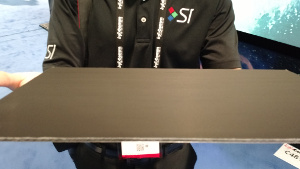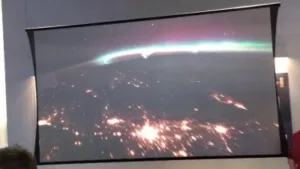Screen Innovation (SI) did their usual energetic sales pitch at their booth at InfoComm where they showcased a number of their screens and introduced a new one call Zero-G, which they dubbed a “Rollable TV’ screen. This is a very nice 30 foot (9m) wide motorized screen that retracts into the ceiling – nothing particularly innovative about that. What they say is different is the screen material used – the first rollable ambient light rejection (ALR) screen material. It is aimed at boardrooms and high end home theaters.

The Zero-G screen uses their Slate material, which comes in 0.8 or 1.2 gain options. The benefits of this material were also being shown in a side-by-side comparison with a standard gray screen. The Slate material rejects about 65% of the ambient light and con be made in screen sizes up to 200 inches (5m) without a seam.
SI’s other primary screen material is their Black Diamond. It has a 45-degree half angle but rejects 85% of the light coming from the left/right and top/bottom directions. This can be made in screen sizes up to 120 inches without a seam and uses an 8-layer screen material.
The company had a nice dual-sided demo they call 360 Rear-pro, that shows projected images on both side of the screen. This has a new formulation that is a little darker for better blacks and little wide viewing cone. The screen gain is 0.7 to 0.8 and it was being illuminated with a Vivitek 8K lumen projector on a 120” screen and it looked very nice.
SI has also developed a short throw screen material that was nicely demonstrated in the two photos below. One was taken at a sharp angle to the screen and shows a black surface (the light absorbing direction). The other photo is the same material rotated 180-degrees and it now looks white (image reflection direction). This material is said to have great contrast, ultra-wide viewing cone (70-degrees), zero hot-spotting, edge-blend capable and supports throw ratios as low as 0.1. Maximum height is 60” for a screen width of 116”.



A very nice product called “Flex Glass” was shown up high in their booth. This is not made of glass, but rather polycarbonate with a glossy black surface and diffuse front surface. It was shown with a 20’ (6m) radius but can be rolled up to a compact 3’ (0.9m) radius for shipment. It comes in a 0.8 gain and has no hot spotting. In the booth, they have 40K lumens lighting up the screen, but they could have used about twice as much light. – CC

